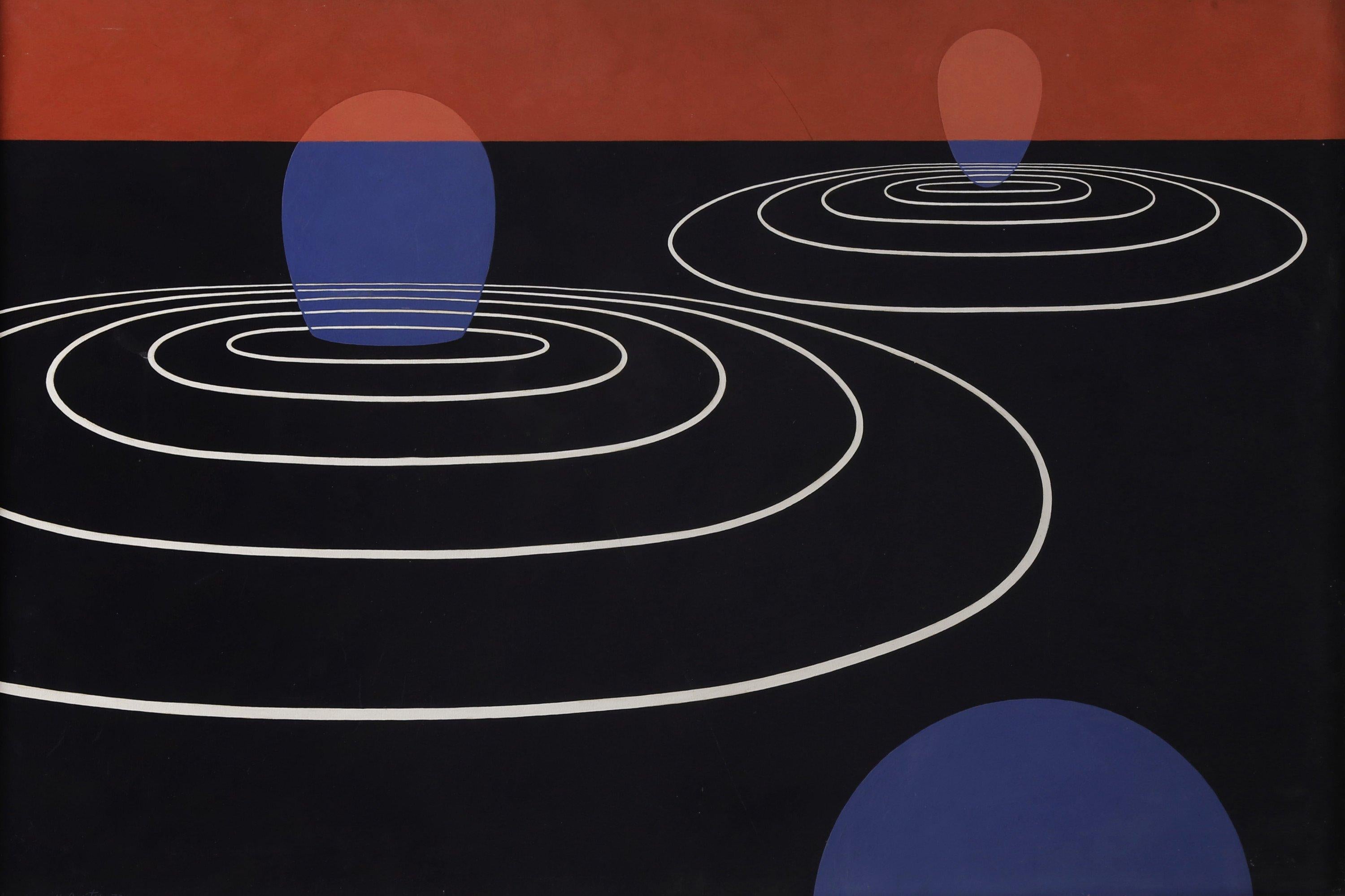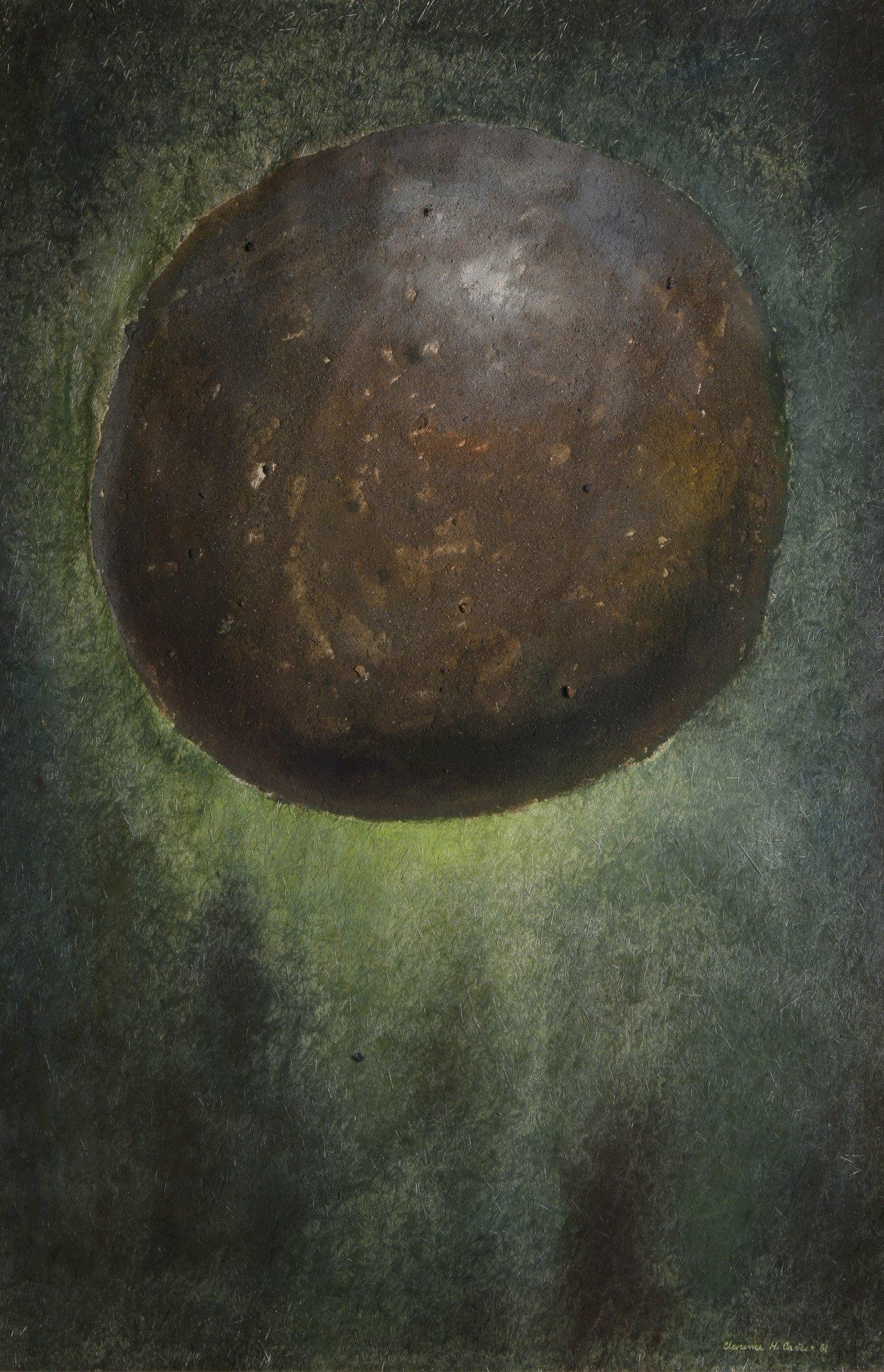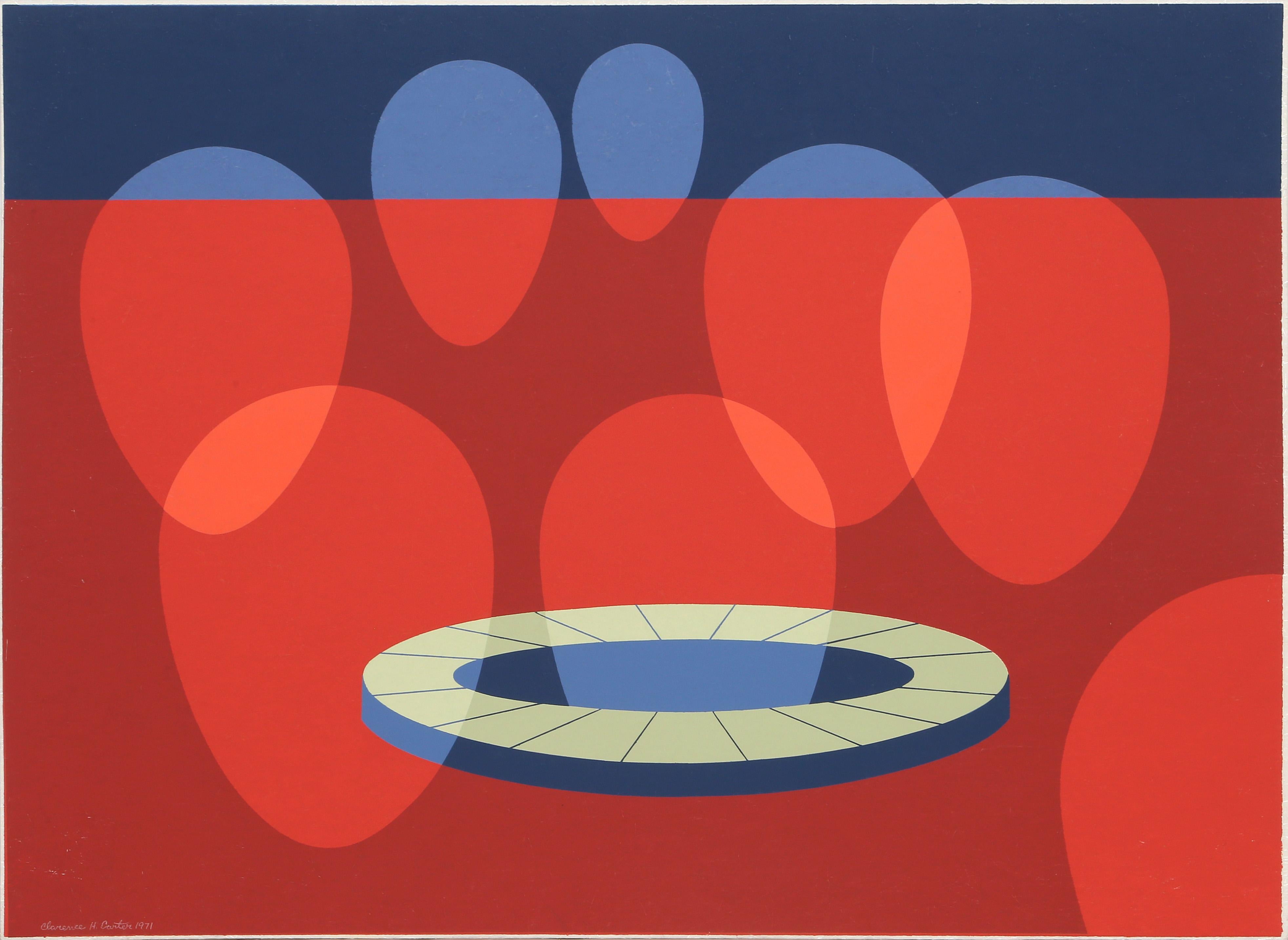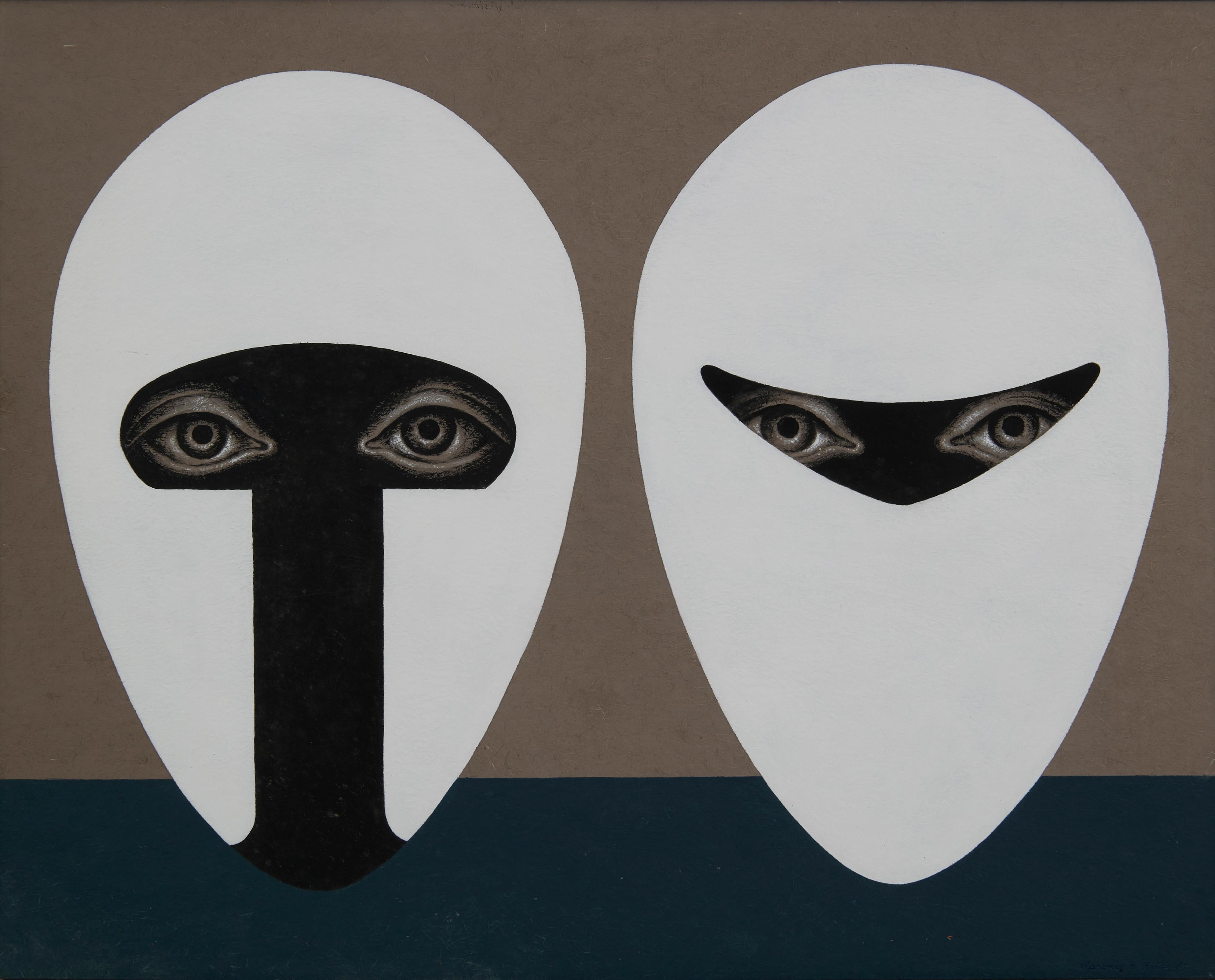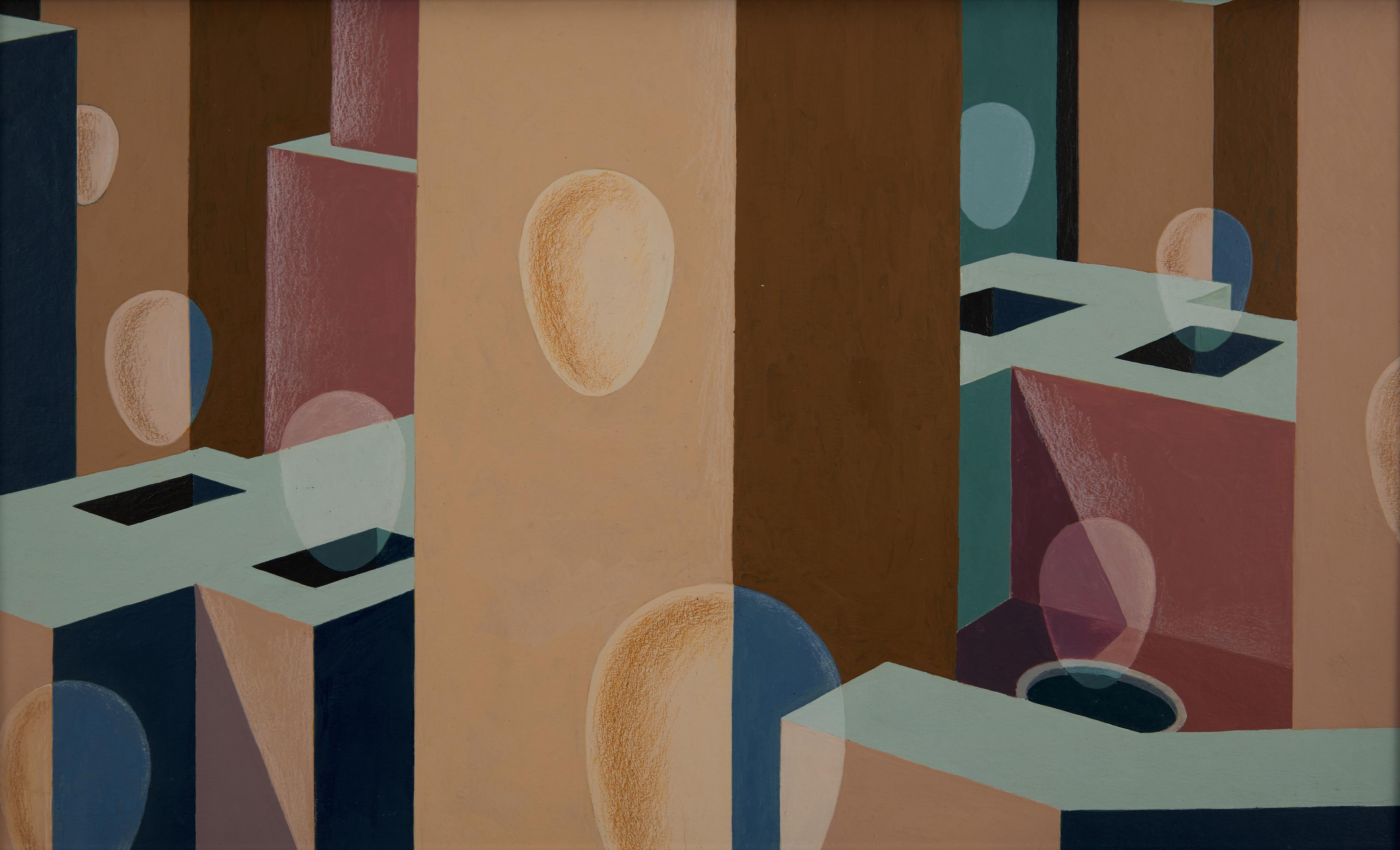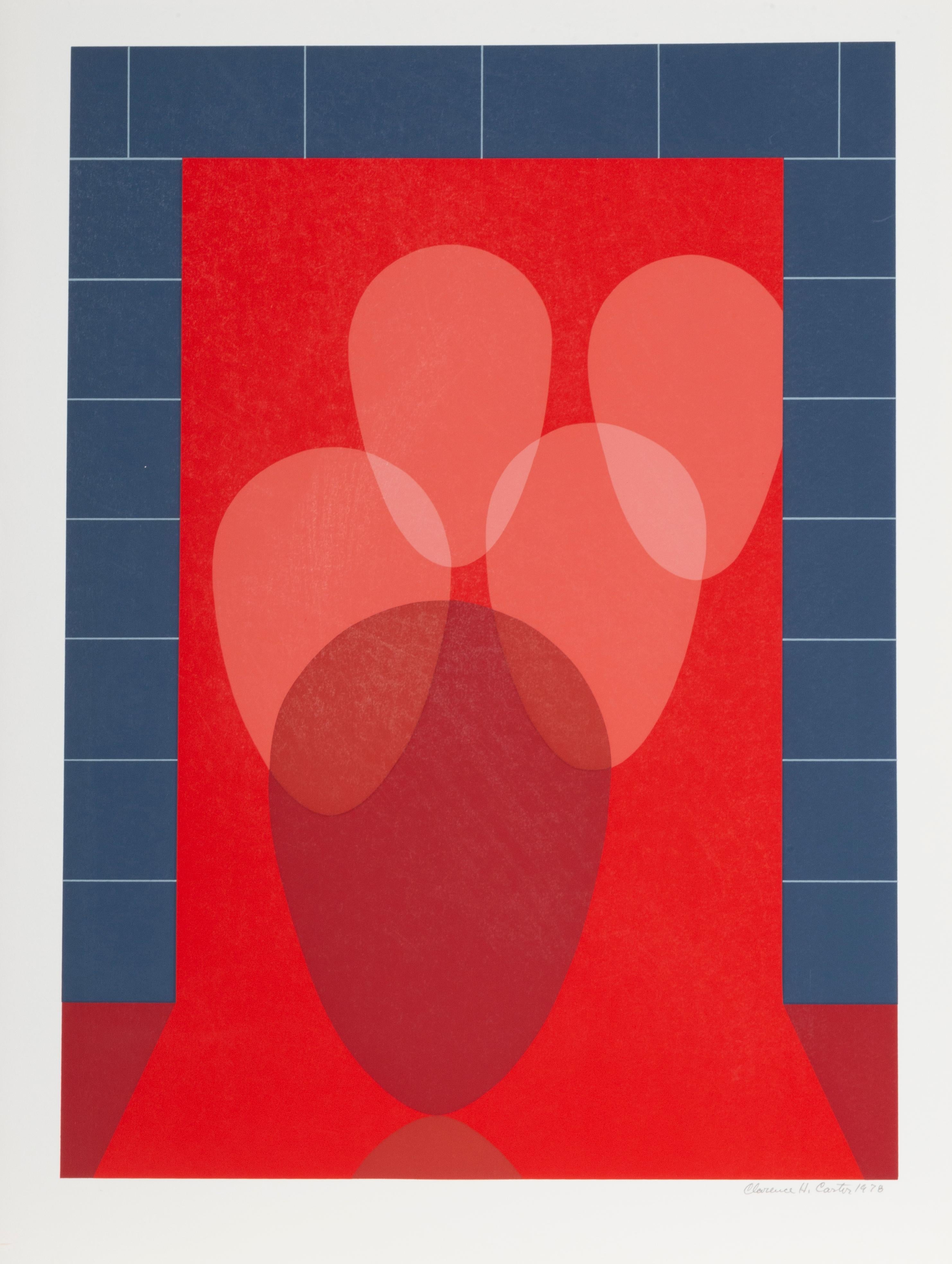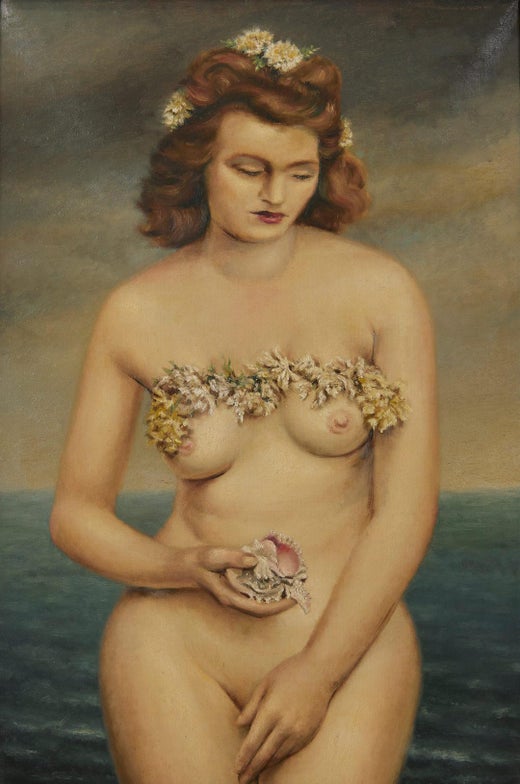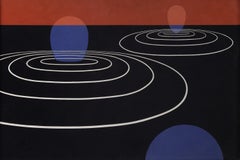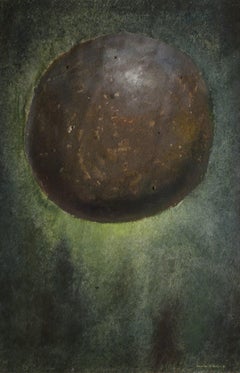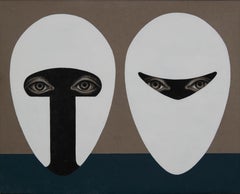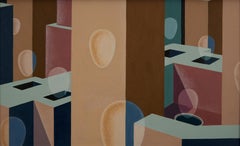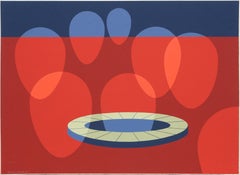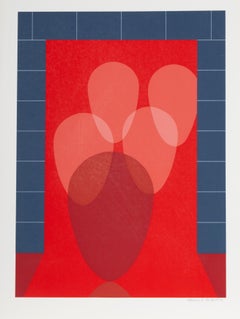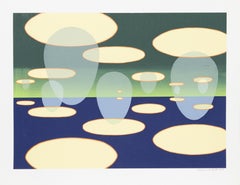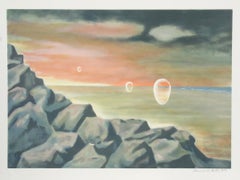Items Similar to Entr'acte - Mid-Century Ovoids in Theatre - Geometrical Abstract Pastel
Want more images or videos?
Request additional images or videos from the seller
1 of 8
Clarence Holbrook CarterEntr'acte - Mid-Century Ovoids in Theatre - Geometrical Abstract Pastel1977
1977
$15,000
£11,320.09
€12,959.79
CA$21,154.97
A$23,225.52
CHF 12,116.80
MX$281,061.15
NOK 151,865.34
SEK 143,097.08
DKK 96,741.36
About the Item
Clarence Holbrook Carter (American, 1904-2000)
Entr'acte, 1977
Pastel on board
Signed and dated lower right
8 x 10 inches
A surrealist mid-century figural abstract painting.
Clarence Holbrook Carter achieved a level of national artistic success that was nearly unprecedented among Cleveland School artists of his day, with representation by major New York dealers, scores of awards and solo exhibits, and streams of praise flowing from pens of the top art critics. Over the course of his 60+ year career Carter evolved from an exceptionally fine American Scene painter capable of evoking deep reservoirs of mood, into an abstractionist with a strongly surrealist bent.
Carter's quest for a symbolic artistic language continued in this period with the introduction for the Ovoid or Egg form into his work. Perfectly suited to his preoccupation with the mysteries of life and the themes of death and transfiguration, the Ovoid or Egg symbolized all of these mysteries in a succinct and visually simple form. The Ovoid/Egg is employed in various fashions to wonderful effect by Carter. It is at once tough and fragile, and in Carter's depictions it is opaque or translucent; it is reminiscent of the shape of a human head, it becomes a substitute for a person or a soul. The Egg/Ovoid that is devoid of human features is given a single eye, or mouth, and is an instantly recognizable reduction of the human being.
- Creator:Clarence Holbrook Carter (1904-2000, American)
- Creation Year:1977
- Dimensions:Height: 12 in (30.48 cm)Width: 14 in (35.56 cm)
- Medium:
- Movement & Style:
- Period:
- Condition:
- Gallery Location:Beachwood, OH
- Reference Number:1stDibs: LU1768211325632
Clarence Holbrook Carter
Clarence Holbrook Carter achieved a level of national artistic success that was nearly unprecedented among Cleveland School artists of his day, with representation by major New York dealers, scores of awards and solo exhibits, and streams of praise flowing from pens of the top art critics. Over the course of his 60+ year career Carter evolved from an exceptionally fine American Scene painter capable of evoking deep reservoirs of mood, into an abstractionist with a strongly surrealist bent. While his two bodies of work seem at first to be worlds apart, owing to their different formal vocabularies, they, in fact, explore virtually the same subject: the nexus between life and death and the transition from earth to spirit. The early work finds its expressive power through specific people, events, and landscapes—most of which are drawn from his experiences growing up in the river town of Portsmouth, Ohio—while the later work from the 1960s on evokes potent states of being through pure flat shape, color and form that read as universals. As his primary form he adopted the ovoid or egg shape, endowing it with varying degrees of transparency. Alone or in multiples, the egg moves through Carter’s landscapes and architectural settings like a sentient spirit on a restless quest. Born and raised in southern Ohio along the banks of the mercurial Ohio River and its treacherous floods, Carter developed a love of drawing as a child, and was encouraged by both his parents. He was self-directed, found inspiration all around him, and was strongly encouraged by the fact that his teenage work consistently captured art prizes in county and state fairs. Carter studied at the Cleveland School of Art from 1923-27, where he trained under painters Henry Keller, Frank Wilcox and Paul Travis. Returning to Cleveland in 1929, Carter had his first solo show, and through Milliken taught studio classes at the Cleveland Museum of Art from 1930-37. In 1938, he moved to Pittsburgh to teach at the Carnegie Institute of Technology until 1944. Carter’s American Scene paintings of the ’30s and ’40s, which launched his artistic star, are the works for which the artist remains best known. During and immediately after World War II, Clarence Carter realized his attraction to bold pattern, dramatic perspective and eye-catching hard-edged design was a poor fit with the prevailing style of Abstract Expressionism. Fortunately, these same hallmarks of his style were prized within the realm of commercial art. Around 1964 Carter acknowledged a need to break from the confines of representational painting. Once Carter had found a potent symbol in the egg, he used it to create an astounding body of imagery for the rest of his life. Among the most ambitious of all his later paintings were his Transections, a theological term meaning to cross, specifically between life and death.
About the Seller
5.0
Platinum Seller
Premium sellers with a 4.7+ rating and 24-hour response times
Established in 1975
1stDibs seller since 2022
39 sales on 1stDibs
Typical response time: <1 hour
- ShippingRetrieving quote...Shipping from: Beachwood, OH
- Return Policy
Authenticity Guarantee
In the unlikely event there’s an issue with an item’s authenticity, contact us within 1 year for a full refund. DetailsMoney-Back Guarantee
If your item is not as described, is damaged in transit, or does not arrive, contact us within 7 days for a full refund. Details24-Hour Cancellation
You have a 24-hour grace period in which to reconsider your purchase, with no questions asked.Vetted Professional Sellers
Our world-class sellers must adhere to strict standards for service and quality, maintaining the integrity of our listings.Price-Match Guarantee
If you find that a seller listed the same item for a lower price elsewhere, we’ll match it.Trusted Global Delivery
Our best-in-class carrier network provides specialized shipping options worldwide, including custom delivery.More From This Seller
View AllReverberations, mid-century abstract surrealist black acrylic painting
By Clarence Holbrook Carter
Located in Beachwood, OH
Clarence Holbrook Carter (American, 1904-2000)
Reverberations, 1970
Acrylic on illustration board
Signed lower left
20 x 30 inches
Mid-century abstract surrealist black acrylic painting...
Category
1970s Surrealist Abstract Paintings
Materials
Acrylic
Departing from the System, Mid-Century Geometrical Abstract Mixed Media
By Clarence Holbrook Carter
Located in Beachwood, OH
Clarence Holbrook Carter (American, 1904-2000)
Departing from the System, 1961
Mixed media on paper
Signed and dated lower right
36 x 24 inches
A surrealist mid-century figural abst...
Category
1960s American Modern Abstract Paintings
Materials
Mixed Media
Medieval Heads, mid-century figural surrealist acrylic painting
By Clarence Holbrook Carter
Located in Beachwood, OH
Clarence Holbrook Carter (American, 1904-2000)
Cicada, c. 1960s
Watercolor on scintilla
30 x 20 inches
Clarence Holbrook Carter achieved a level of national artistic success that wa...
Category
1960s American Modern Figurative Paintings
Materials
Acrylic
Transection w/ Architectural Forms, Geometrical Figurative Abstract Acrylic
By Clarence Holbrook Carter
Located in Beachwood, OH
Clarence Holbrook Carter (American, 1904-2000)
Transection with Architectural Forms, c. 1980s
Acrylic and graphite on board
12 x 20 inches
A surrealist mid-century figural abstract ...
Category
1980s American Modern Abstract Paintings
Materials
Acrylic, Graphite
Chimeras, mid-century figural abstract blue acrylic painting
By Clarence Holbrook Carter
Located in Beachwood, OH
Chimeras, 1974
Acrylic and pastel on textured paper
Mid-century figural abstract blue acrylic painting
Clarence Holbrook Carter achieved a level of national artistic success that w...
Category
1970s American Modern Figurative Paintings
Materials
Pastel, Acrylic
Ablaze, Ovoid Faces Looking Through Geometrical Windows
By Clarence Holbrook Carter
Located in Beachwood, OH
Clarence Holbrook Carter (American, 1904-2000)
Ablaze, 1973-79
Acrylic and collage on scintilla
Signed and dated lower left
30 x 22 inches
A surrealist mid-century figural abstract...
Category
1970s American Modern Abstract Paintings
Materials
Acrylic
You May Also Like
Joseph and His Brothers, Surrealist Screenprint by Clarence Holbrook Carter
By Clarence Holbrook Carter
Located in Long Island City, NY
Artist: Clarence Holbrook Carter, American (1904 - 2000)
Title: Joseph and his Brothers
Year: 1971
Medium: Screenprint on Scintilla paper, sign...
Category
1970s Abstract Abstract Prints
Materials
Screen
Fiery Furnace, Surrealist Screenprint by Clarence Holbrook Carter
By Clarence Holbrook Carter
Located in Long Island City, NY
Artist: Clarence Holbrook Carter, American (1904 - 2000)
Title: Fiery Furnace
Year: 1978
Medium: Serigraph, signed and numbered in pencil
Edition: 200, AP 30
Paper Size: 35 x 26 inc...
Category
1970s Surrealist Abstract Prints
Materials
Screen
Eschantos 31, Screenprint by Clarence Holbrook Carter
By Clarence Holbrook Carter
Located in Long Island City, NY
Artist: Clarence Holbrook Carter, American (1904 - 2000)
Title: Eschantos 31
Year: 1978
Medium: Serigraph, signed and numbered in pencil
Edition: 200, 30 AP
Size: 26 in. x 33.5 in. (...
Category
1970s Surrealist Abstract Prints
Materials
Screen
Eschatos #21, Surrealist Landscape Screenprint by Clarence Holbrook Carter
By Clarence Holbrook Carter
Located in Long Island City, NY
Artist: Clarence Holbrook Carter, American (1904 - 2000)
Title: Eschatos 21
Medium: Screenprint, signed and numbered in pencil
Edition: 200, 30 AP
Size: 23 in. x 29 in. (58.42 cm x 7...
Category
1970s Surrealist Landscape Prints
Materials
Screen
Transection No. 7, Large Painting by Clarence Carter
By Clarence Holbrook Carter
Located in Long Island City, NY
Artist: Clarence Holbrook Carter, American (1904 - 1998)
Title: Transection No. 7
Year: 1970
Medium: Acrylic on Canvas, signed verso
Size: 77 in. x 75.5 in. (195.58 cm x 191.77 c...
Category
1970s Abstract Geometric Abstract Paintings
Materials
Oil
Transection I, Silkscreen by Clarence Carter 1971
By Clarence Holbrook Carter
Located in Long Island City, NY
Artist: Clarence Holbrook Carter, American (1904 - 2000)
Title: Transection I
Year: 1971
Medium: Screenprint on Scintilla paper, signed and numbered in pencil
Edition: 75
Paper Size:...
Category
1970s Op Art Abstract Prints
Materials
Screen
